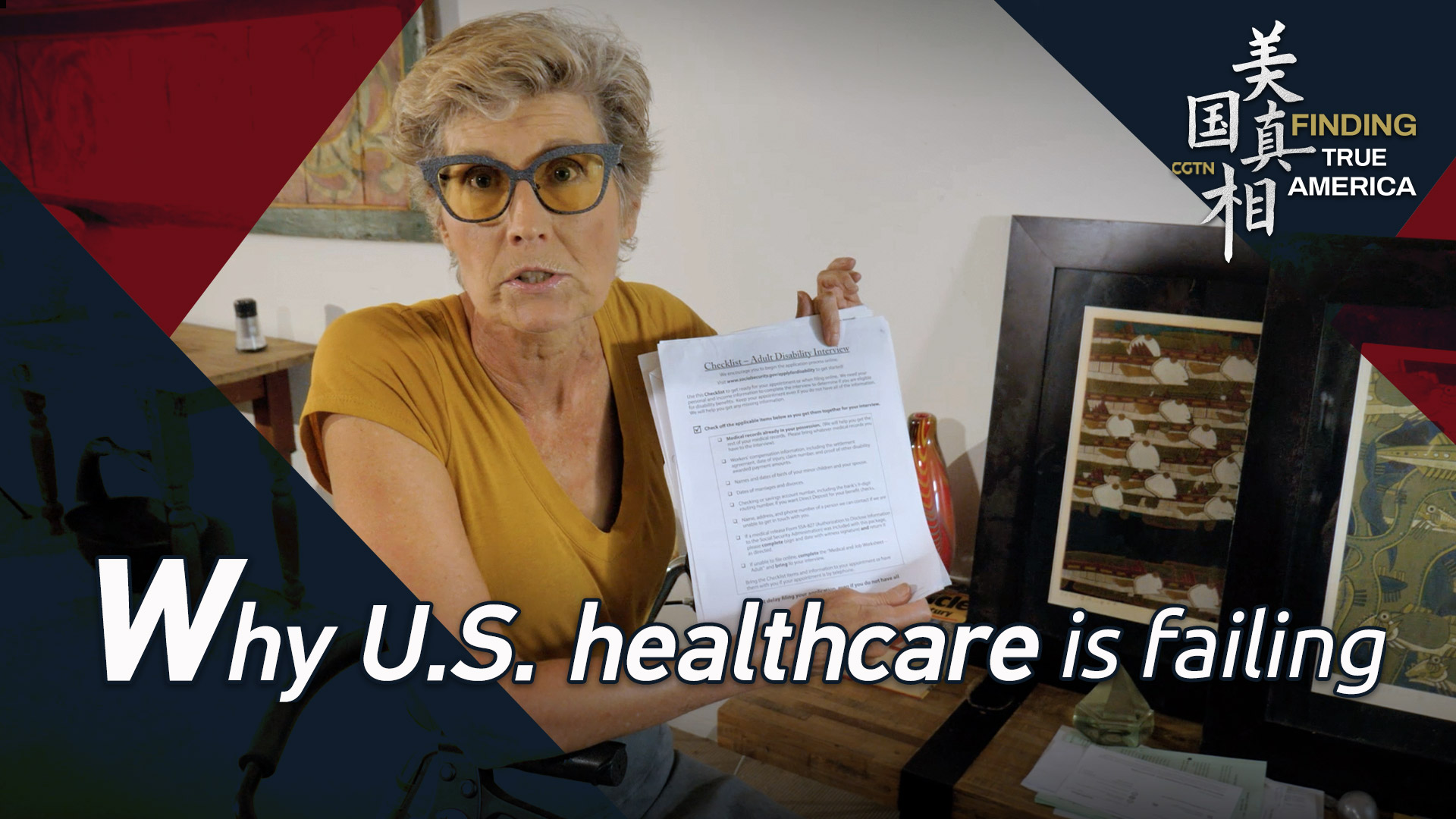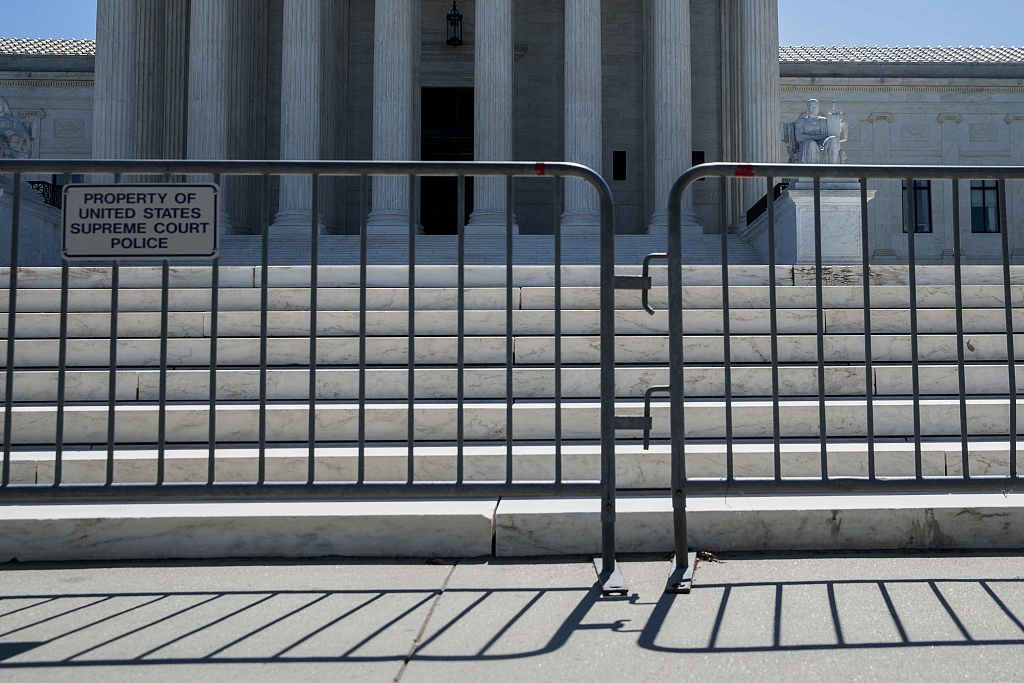06:05

As mid-July approaches, millions of Americans face the devastating prospect of losing healthcare coverage through Medicaid, a government-run program that provides medical coverage to low-income individuals and families.
According to an estimate released last month by the Kaiser Family Foundation, 5.3 million to 14.2 million people could lose their Medicaid coverage if the COVID-19 public health emergency is not extended beyond July 15.
The fact is, America's woes amid the COVID-19 pandemic are just the tip of the iceberg. Inequality, fragmentation and politicization are rampant in the U.S. healthcare system.
An endless battle for affordable healthcare
"I've spent my entire life battling the American healthcare system," said Christine Martin, a 61-year-old former special education teacher. Her story reflects the harsh reality for many Americans.
In 2017, Martin broke her back and was almost paralyzed from the waist down. Her insurance provider denied her request to get transferred, and without quick treatment she was left in extreme agony. After she was discharged, the financial pain hit. The former teacher was landed with tens of thousands of dollars in medical bills.
Despite having many insurance policies, from Medi-Cal and Blue Shield to Blue Cross and, eventually, Kaiser, Martin was haunted by the same problem of paying large insurance premiums but having difficulty accessing treatment.
She and her husband have good incomes, but they can't afford the co-pays – a fixed out-of-pocket amount paid by an insured for covered services – for any kind of decent health insurance.
"The medical establishment in this country is making everything so complicated and so unnecessarily difficult that you're just gonna give up," said Martin.
"There are tens, hundreds of thousands of people with a very similar story to my own facing worse daily choices, between do they take care of their homes, their environment, their loved ones, or do they take care of their own physical needs to get through one more day?"

Medical staff treat a COVID-19 patient in an isolation room on the Intensive Care Unit at Western Reserve Hospital in Cuyahoga Falls, Ohio, U.S., January 4, 2022. /Reuters
Medical staff treat a COVID-19 patient in an isolation room on the Intensive Care Unit at Western Reserve Hospital in Cuyahoga Falls, Ohio, U.S., January 4, 2022. /Reuters
An unequal, complicated and expensive system
Article 25 of the United Nations' Universal Declaration of Human Rights says, "Everyone has the right to a standard of living adequate for the health and well-being of himself and of his family, including food, clothing, housing and medical care and necessary social services."
The United States remains the only high-income country lacking universal health insurance coverage and trails far behind other high-income countries on healthcare affordability, administrative efficiency, equity and outcomes, according to the annual report issued last year by the Commonwealth Fund, a healthcare charity.
Nearly 30 million people are still uninsured, and some 40 million with health plans are potentially underinsured, the report said.
Most Americans use a combination of private and public medical insurance. As there is no single nationwide health insurance system, the U.S. primarily expects employers to voluntarily provide health insurance coverage to their employees and their dependents.
But not all companies offer health benefits to their employees — among all firms the percentage of employees covered by self-funded plans increased from 44 percent in 1999 to a record high of 67 percent in 2020 before decreasing slightly to 64 percent in 2021, according to Statista, a business data service company.
Kee Park, a faculty member at Harvard Medical School and a consultant for the World Health Organization, told CGTN that the U.S. healthcare system is very "fragmented and with multiple payers."
"The system is for profit, and it's industry-driven in many ways. It's poorly regulated," Park said.
And as Park points out, the profit-orientated system makes healthcare expensive.
"Even in the middle of a public health emergency, we've seen major insurance companies continue to put their profits before the health of our communities," said House Representative Katie Porter, a Democrat from California, while introducing a bill to protect patients during public health emergencies.
Hospitals operate on a for-profit basis. By the end of 2020, HCA Healthcare, the country's largest for-profit hospital network, posted a $3.8 billion profit, more than it made the year before the pandemic began. Others are also getting a slice of the pie. Tenet Healthcare, a multinational healthcare services company, made almost $400 million in profits.
The average annual cost of health insurance in the U.S. is $7,739 for an individual and $22,221 for a family as of 2021, according to the Kaiser Family Foundation.
"We hear politicians say all the time that we have the best healthcare system in the world. We have fabulous doctors and healthcare facilities, but they're off-limits to a lot of people because of the cost," said Wendell Potter, a former communications director at the insurance giant Cigna.
The politics of healthcare policy
It is no secret that the healthcare system in the U.S. is a field of complicated policy language and fierce political division.
In 2010, the Affordable Care Act (ACA), also known as Obamacare, was signed into law, introducing significant reforms to the national healthcare policy. Five years later, almost 90 percent of adults in the U.S. had access to healthcare. More and more poor people could afford to see a doctor.
However, two years later, in 2017, the first executive order Donald Trump signed after taking office as president was an attempt to begin the process of repealing Obamacare. Shortly afterwards, many insurance companies, such as UnitedHealth Group, withdrew from the plan.
Though Trump weakened Obama's signature healthcare plan by limiting funding and reducing access – which sent premiums up – he ultimately failed to repeal it. According to the Brookings Institution, the former president's "sabotage strategy" had only modest gains and the ACA remained largely resilient. In 2021, the Supreme Court upheld the ACA against Republican calls for its individual mandate to be ruled unconstitutional.

A security fence outside the U.S. Supreme Court in Washington, D.C., U.S., June 17, 2021. The Supreme Court upholds the Affordable Care Act, rejecting a challenge by Republican-controlled states and former President Donald Trump's administration to a landmark law that provides health insurance to 20 million people. /CFP
A security fence outside the U.S. Supreme Court in Washington, D.C., U.S., June 17, 2021. The Supreme Court upholds the Affordable Care Act, rejecting a challenge by Republican-controlled states and former President Donald Trump's administration to a landmark law that provides health insurance to 20 million people. /CFP
President Joe Biden rolled back many of the Trump administration's reforms, brought down the cost of healthcare and pushed more people into government-run coverage by reopening the Obamacare exchanges and quadrupling the number of organizations charged with enrolling individuals in government coverage.
"The prospect of changing the healthcare system generates resistance because there are huge economic interests vested in the current structure: pharmaceutical, construction, equipment, information technology. It is the largest sector of the U.S. economy and 10 percent of the global economy. And healthcare is a major political issue," said Julio Frenk, dean of the Harvard School of Public Health.
John DiIulio, a professor at the University of Pennsylvania, also pointed out how politics impacts attempts to reform the healthcare system.
"Federal healthcare reform, whatever form it finally takes, is once again an irresistible political force. But when an irresistible political force meets an immovable administrative object, bet on the object," Dilulio wrote in an article published on the website of the Brookings Institution.
The American system hasn't served people like Christine Martin well, and despite constant calls to make healthcare more affordable for the many, the outlook over the coming decade is grim.
The Centers for Medicare & Medicaid Services Office of the Actuary predicts that national healthcare spending is expected to outpace GDP growth until 2023. Spending is predicted to reach $6.19 trillion in 2028 and account for 19.7 percent of GDP.
Data published by the Association of American Medical Colleges postulates that the U.S. will experience a shortage of between 54,100 and 139,000 primary and specialty care physicians by 2033 as demand increases.
Achieving better health outcomes will require policy changes within and beyond healthcare, like expanding insurance coverage, extending primary care to every local community and having smarter spending, a Commonwealth Fund report said.

